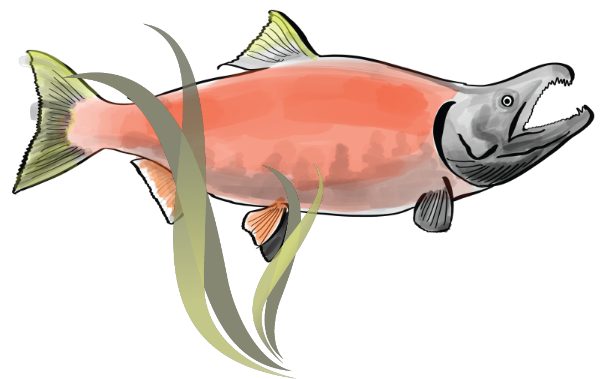
ᐊᖏᔫᔪᒥ, ᖃᔅᓯᒐᓚᖕᓄᑦ−ᓄᓇᖃᖃᑎᒌᒃᑐᑦ ᐳᕆᑎᔅ ᑲᓚᒻᐱᐊᒥᑦ ᐃᖃᓗᒃᐱᓂᑦ ᐅᑎᖅᑎᑦᑎᓇᓱᐊᕐᓂᖅ ᐊᒻᒪᓗ ᐃᓱᒪᑐᔪᓂ ᐱᓕᕆᐊᒃᓴᖅ
ᑐᙵᖓᕕᒃ ᐃᓚᐅᑎᑦᑎᕗᖅ ᓄᓇᖃᖅᑳᖅᓯᒪᔪᓄᑦ ᑲᑎᙵᔪᓂᑦ ᐊᒻᒪ ᓄᓇᓕᖕᓂᑦ ᓇᓗᓇᐃᖅᓯᓂᖏᓐᓂ ᐱᑕᖃᑐᐃᓐᓇᕆᐊᓕᖕᓂ ᐊᖏᔫᑎᓂᑦ ᖃᔅᓯᒐᓚᖕᓄᑦ−ᓄᓇᖃᖃᑎᒌᒃᑐᓄᑦ ᐃᑲᔪᖅᓯᖅᑕᐅᔪᓐᓇᖅᑐᓂ ᐳᕆᑎᔅ ᑲᓚᒻᐱᐊᒥ ᐃᖃᓗᒃᐱᓄᑦ ᐅᑎᖅᑎᑦᑎᓂᖅ ᐊᒻᒪᓗ ᐊᔾᔨᒋᙱᑕᖏᓐᓂᒃ ᐱᓕᕆᓂᕐᒧᑦ ᑮᓇᐅᔭᓂᑦ. ᐅᓇ ᐱᓕᕆᓂᖅ ᐊᔭᐅᕆᓂᐊᖅᐳᖅ ᐊᖏᒡᓕᒋᐊᖅᑐᒥ ᓄᓇᖃᖅᑳᖅᓯᒪᔪᓄᑦ ᐃᓚᐅᓂᐅᔪᒥ ᖃᐅᔨᓴᕐᓂᕐᓄᑦ ᐱᓕᕆᖃᑎᒌᖕᓂᐅᔪᓂ, ᐃᓱᒪᑐᓂᕐᓂ, ᐊᒻᒪ ᓄᓇᓕᖕᓂ ᐊᑐᖅᐸᒃᑕᖏᓐᓂ ᐊᐅᓚᔪᓐᓇᖁᓪᓗᒋᑦ ᑮᓇᐅᔭᓂᒃ ᐱᕈᖅᑎᑦᑎᓇᓱᖕᓂᕐᒧᑦ ᑐᖅᑯᖅᓯᓂᐅᔪᓂᑦ ᐱᐅᓯᒋᐊᖅᑎᑦᑎᓇᔭᖅᑐᒥ ᓴᖅᑭᑎᑦᑎᓂᐅᔪᒥ, ᒪᑭᒪᒍᑕᐅᔪᓐᓇᖅᑐᓂ, ᐊᒻᒪ ᐊᑦᑕᓇᙱᑦᑐᒥ ᓴᓇᕝᕕᓕᒫᖏᓐᓂ.
A brief description of each concept is as follows:
1. Standardized salmonid/ecological monitoring and data collection tools and training
Concept: BCSRIF funds would support:
- Inventory existing tools used by groups and communities to monitor and/or collect data on fish stocks, fisheries, habitat and water quality, flow damage/obstruction, land changes and vulnerabilities to riparian zones and habitats
- Establish best tools for these activities and those who need them
- Bring together AAROMs and gov’t partners to agree upon: 1) standardized tools for monitoring and data collection, 2) training required, 3) data-sharing protocol
- Identify opportunities for AAROMs and First Nations to offer monitoring and data collection services to governments under contract
Concept: BCSRIF funds would support AAROMs to:
- Two to four pilots (to start) with AAROMs gathering baseline data and subsequent data to compare landscape shi”s
- Interpreted GIS data would then be used to develop community-based watershed maps (that would inform long-term risk vulnerability mitigation/response planning processes)
- Interpreted data to be shared on an online platform
- Collaborative decision-making to establish online platform and coordination lead
- Partnership with University of Victoria’s Map Shop Collaborative
- Interpreted data to be shared on an online platform
- Collaborative decision-making to establish online platform and coordination lead
3. AAROM involvement in the Pacific Salmon-Ecosystem Climate Consortium
Concept: BCSRIF funds would support AAROMs to become partners in the Pacific Climate Impacts Consortium and the scientific work undertaken by it
- AAROMs review their past studies/research partnerships on climate impacts on salmon and habitat to prepare for a one- or two-day session involving DFO and other scientists
- Final report from session would outline a work plan for AAROM/member community monitors identified in concept #1 to collect data to inform broad salmon rebuilding/habitat restoration
- Phase two would support AAROM/member community monitors to implement the work plan and other watershed partnership research
4. First Nations estuary habitat management plans (fisheries focussed)
Concept: BCSRIF funds would support AAROMs to develop estuary habitat management plans to help First Nations articulate their fisheries priorities at marine spatial planning technical and decision-making tables
- AAROMs review their past studies/research partnerships on climate impacts on salmon and habitat to prepare for a one- or two-day session involving DFO and other scientists
- Working with AAROMs to assess current estuary habitat management planning (and plans, if they exist) and to update/develop plans
- Leveraging First Nations best practises and filling the gaps as marine spatial planning activities accelerate
5. Dealing with salmonid habitat impacts by other industries
Concept: BCSRIF funds would support AAROMs and BC First Nations to build capacity to be more involved in habitat remediation economic opportunities, including through procurement
- Capacity building would enable increased First Nations participation in other habitat remediation programs (i.e., those set up to remove dams or culverts or to deal with the impacts of mining, forestry or agriculture)
- Support for mentoring and business development
- Leveraging First Nations best practises
6. First Nation natural disaster contact network
Concept: BCSRIF funds would support the development and maintenance of a BC First Nations Natural Disaster Network
- BC-wide First Nations contact list for federal, provincial and municipal governments to more easily (and quickly) collaborate during natural disasters and environmental events
- Based on lessons learned during Big Bar landslide event (and other past events)
- Opportunity for small amounts of funding to make a difference each year to communities
- Good employment opportunity for First Nations student (intern)
7. Aquaculture water quality, science and monitoring
Concept: BCSRIF funds would support more BC First Nations to:
- Monitor marine aquaculture facility water quality and wastewater disposal
- Collect data and information regarding water usage and environmental health of surrounding operations
- Undertake scientific research to inform water quality related decision-making
8. Salmonid rebuilding strategy
Concept to be developed as a result of January 2020 workshops with AAROMs and other Institute-FNFC engagement sessions
- Opportunity for AAROMs and others to share their ideas building from Made-in-BC Wild Salmon Strategy and Wild Salmon Policy
- Collection of success stories about streams, lakes, rivers, estuaries, etc. that have seen changes as a result of programs and activities
- Identification of economic opportunities which would enable salmonid rebuilding


